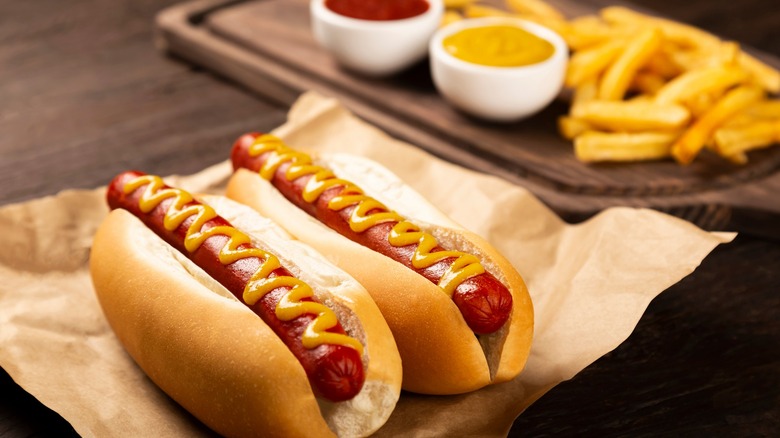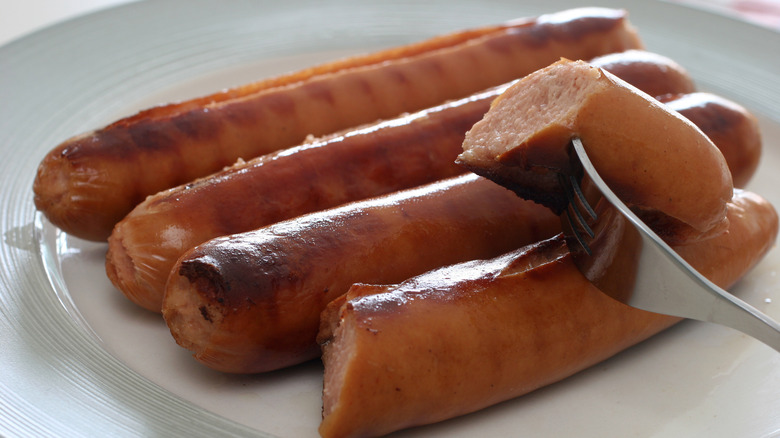The Hot Dog Defrosting Mistake You Need To Avoid
There's no denying that summer belongs to the outdoor cookout. After all, nothing gets people to gather in good cheer to beat the heat like grilled meats and veggies. And regardless of which type of protein is the main attraction, hot dogs are typically found in tow. This is mainly because of how quickly and effortlessly they can be cooked on a grill. However, there are a few things you shouldn't do when cooking hot dogs, regardless of whether you're grilling or boiling them. And one of the biggest mistakes you can make involves defrosting.
Although hot dogs require very little cooking time because they come from the grocery store fully cooked, many barbeque aficionados freeze the franks before cooking to ensure they stay fresh until the big day. This can lead to mishaps when it comes time to cook, particularly if they're thrown onto an open flame straight from the freezer, which is a big mistake. This is because the frozen protein's exterior will likely scorch long before the inside even thaws out.
Things to avoid when defrosting hot dogs
As Men's Health reports, "You should never cook anything frozen. You should always thaw your food in the fridge overnight and then allow it to come to room temperature before putting it on the grill." This is true for any cut of meat, including hot dogs. Although there are other safe methods, like microwaving or thawing under cold water, according to the USDA, defrosting food in a refrigerator is considered the safest and most effective. Your fridge will maintain a consistent temperature, letting the meat thaw gradually and preserving the integrity of the product, while keeping bacteria like listeria monocytogenes (which cause listeriosis and can be found in hot dogs) from developing.
Microwaving, a common method for thawing, isn't the most lauded of techniques. Your microwave has the potential to ruin your franks since each machine's power range varies (too high a power setting could degrade the quality of the meat). Additionally, the cold water technique for thawing presents risks, as well.
When thawing hot dogs in cold water, the liquid's temperature will climb as the meat defrosts. This could place the protein within the "danger zone" — a temperature range between 40 and 140 degrees Fahrenheit that encourages bacterial growth — which is significant because thawing foods don't defrost evenly. This means that even though the meat's exterior may have softened, it could still be rock-solid on the inside.
Things to consider when thawing hot dogs in the fridge
While thawing hot dogs in the fridge is the safest way to bring your frankfurters to room temperature, it's not as fast as the other two methods mentioned. Thawing your dogs in the refrigerator can take anywhere from a few hours to a few days depending on their size. Still, it's the best method for defrosting and luckily, an unopened package of frankfurters can last up to two whole weeks in the fridge. This could be why Tyson Foods recommends leaving those hot dogs in your fridge for a full 72 hours in order to properly defrost. After all, the conditions won't hinder the meat, and the extra time guarantees that the product will be wholly thawed prior to grilling.
Once you've properly defrosted your dogs, it's important to then cook hot dogs to the right degree of doneness. Although some suggest a minimum temperature of 140 degrees Fahrenheit, the USDA recommends that fully cooked meats should reach internal temperatures of 165 degrees Fahrenheit before consumption. Once that's achieved, the world is your oyster and a bunch of fun hot dog tricks are a must-try.


